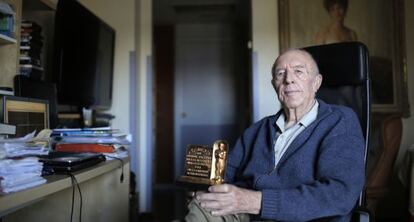“The Spanish royal palace even had microphones in the bathrooms”
Inventor Juan de la Cierva designed the king’s security system and won Spain its first Oscar

Most biographies of inventors confine themselves to their subjects’ activities in the workshop or laboratory, but a study of the life of Juan de la Cierva y Hoces would be far from complete if it only included the advances he contributed to the movie industry – he was the first Spaniard to win an Oscar: in 1970, for a camera stabilizer.
Less well known is his work creating weapons systems for the Spanish military and his relationship with King Juan Carlos I in the early days of Spain’s transition back to democracy in the 1970s, when he designed the security systems for the Zarzuela royal palace in Madrid.
I can’t talk about what I did in the US or the projects I was involved in. It’s all still secret”
Now aged 86, De la Cierva lives in a retirement home in the Spanish capital – “where I don’t have to worry about anything” – allowing him to remain active: he’s currently working on a design for a chairlift. Over the years he’s patented 48 inventions, as well as come up with “around eight or 10 that the Defense Department wouldn’t let me.”
He says his favorite invention is the Dynalens, an optical stabilizer that keeps cameras steady when in motion. He came up with the idea so he could film his children waterskiing, and it later won him an Academy Award, but the idea also had military and defense uses.
After a successful career in the United States, De la Cierva returned to Spain in 1975 as the country was returning to democracy after four decades of military rule under General Francisco Franco. De la Cierva set up information technology pioneer Electroóptica, employing almost 200 people, and came up with a series of devices that won it markets around the world, among them a fraud-proof betting totalizator. “It surprised me how skeptical US customs were, asking what a bunch of Spaniards was doing installing computers in US companies. It was hard to believe, but we had cutting-edge technology,” he says.
“Not CEO, but inventor”
Juan De la Cierva’s explanation as to why he left Spain in such a hurry in 1979 is surprising: “At that time, labor unions had just been legalized, and the first polls to elect representatives in the workplace were being held. I got my engineers together to tell them that I didn’t want communist or socialist labor unions in my company, but the elections went ahead and the CC OO union won, so I left. I just left them to it.”
His brother, Ricardo de Cierva, enjoyed a brief political career as a minister in the Adolfo Suárez government in the early 1980s. In an interview with news magazine Intervíu in June 1979, he was asked whether his brother's decision to quit Spain so suddenly would affect his political career. Six months later Cierva was appointed culture minister, although he only held on to the post for six months. He denied that his brother had taken military secrets with him, but admitted that Juan had installed the security systems in La Moncloa and La Zarzuela.
The 193 workers at Electroóptica ended up bringing a lawsuit against Juan de la Cierva y Hoces: the company had not paid its workforce’s social security contributions. A former employee says that De la Cierva’s strong point was “not management, but inventing things: that’s what it said on his business card, not CEO, but inventor.”
Electroóptica also won contracts with the Spanish armed forces, the most important of which was probably the Meroka anti-missile system that is still used by the Spanish navy.
Then, in 1979, De la Cierva suddenly fled to the United States. Before he left, he allegedly microfilmed his entire archive and placed it in a US bank.
Prior to his departure, De la Cierva had developed a close relationship with the-then Prince Juan Carlos, carrying out a series of delicate missions on behalf of Spain’s future monarch. One of these involved designing a communications system for him. He also handed over his house to Juan Carlos so he could make secure phone calls there. “I would sit on the back of the king’s motorbike. We would leave by a back door and head for my house out in the country. He could telephone from there without anybody listening in,” he says.
De la Cierva says that, at the time, the Zarzuela royal palace was bugged from top to bottom. “There were even microphones in the bathrooms,” he says, explaining that he brought in special bug-detectors from the United States.
He also admits he scanned the La Moncloa prime minister’s palace when Adolfo Suárez, Spain’s first leader of the democratic era, was in office.
He stayed in the United States until 1997, during which time nothing is known about his activities. Did he work for the US Defense Department? “I can’t talk about what I did or the projects I was involved in. It’s all still secret,” he says.
He says he only returned to Spain because his wife was dying, and after she passed on, he decided to stay. He never attends conferences and rarely speaks to the media, preferring to spend his time with his 10 grandchildren and two great-grandchildren. He says he has never properly retired, and continues to work on new projects, his hands tapping away on the keyboard of one of the three computers in his small room with an energy that belies his 86 years.
Tu suscripción se está usando en otro dispositivo
¿Quieres añadir otro usuario a tu suscripción?
Si continúas leyendo en este dispositivo, no se podrá leer en el otro.
FlechaTu suscripción se está usando en otro dispositivo y solo puedes acceder a EL PAÍS desde un dispositivo a la vez.
Si quieres compartir tu cuenta, cambia tu suscripción a la modalidad Premium, así podrás añadir otro usuario. Cada uno accederá con su propia cuenta de email, lo que os permitirá personalizar vuestra experiencia en EL PAÍS.
En el caso de no saber quién está usando tu cuenta, te recomendamos cambiar tu contraseña aquí.
Si decides continuar compartiendo tu cuenta, este mensaje se mostrará en tu dispositivo y en el de la otra persona que está usando tu cuenta de forma indefinida, afectando a tu experiencia de lectura. Puedes consultar aquí los términos y condiciones de la suscripción digital.







































